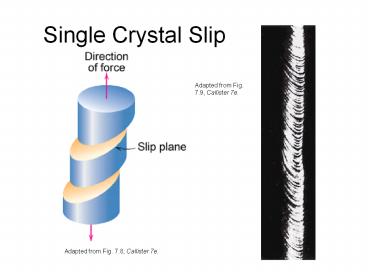Single Crystal Slip - PowerPoint PPT Presentation
Title:
Single Crystal Slip
Description:
Single Crystal Slip Adapted from Fig. 7.9, Callister 7e. Adapted from Fig. 7.8, Callister 7e. Calculation of Theoretical Shear Stress for a Perfect Lattice ... – PowerPoint PPT presentation
Number of Views:350
Avg rating:3.0/5.0
Title: Single Crystal Slip
1
Single Crystal Slip
Adapted from Fig. 7.9, Callister 7e.
Adapted from Fig. 7.8, Callister 7e.
2
Calculation of Theoretical Shear Stress for a
Perfect Lattice
G. Dieter, Mechanical Metallurgy, 3rd Edition,
McGraw-Hill, 1986.
3
Dislocation Concept
- Concept of dislocation was first introduced to
explain the discrepancy between observed and
theoretical shear strengths - For the dislocation concept to be valid
- The motion of a dislocation through a lattice
must require less stress than the theoretical
shear stress - The movement of dislocations must produce steps
or slip bands at free surfaces
4
Cottrell Energy Argument
- Plastic deformation is transition from unslipped
to slipped state - The process is opposed by an energy barrier
- To minimize energy the slipped material will grow
by advance of an interfacial region (dislocation) - To minimize energy of transition interface
thickness, w, small - Distance w is width of dislocation
- Smaller w lower interfacial energy
- Larger w lower elastic energy of the crystal
atomic spacing in the slip direction is closer to
atomic spacing - Equilibrium width is a balance of these two
components
G. Dieter, Mechanical Metallurgy, 3rd Edition,
McGraw-Hill, 1986.
5
Peierls-Nabarro Force
- Dislocation width determines the force required
to move a dislocation through a crystal lattice - Peierls stress is the shear stress required to
move a dislocation through a crystal lattice - Note wide dislocations require lower stress to
move - Makes sense Wide the highly distorted region
at core is not localized on any particular atom - In ductile metals the dislocation width is on the
order of 10 atomic spacings
a is distance between slip planes b is the
distance between atoms in the slip direction
In ceramics with directional covalent bonds
high interfacial energy, dislocations are narrow
relatively immobile Combined with restrictions
on slip systems imposed by electrostatic forces
low degree of plasticity
6
Dislocation Motion
7
Dislocation Motion
- Dislocations plastic deformation
- Cubic hexagonal metals - plastic deformation by
plastic shear or slip where one plane of atoms
slides over adjacent plane by defect motion
(dislocations).
- If dislocations don't move,
deformation doesn't occur!
Adapted from Fig. 7.1, Callister 7e.
8
Dislocation Motion
- Dislocation moves along slip plane in slip
direction perpendicular to dislocation line - Slip direction same direction as Burgers vector
Edge dislocation
Adapted from Fig. 7.2, Callister 7e.
Screw dislocation
9
Definition of a Slip System
- Slip plane - plane allowing easiest slippage
- Minimize atomic distortion (energy) associated
with dislocation motion - Wide interplanar spacings - highest planar atomic
densities (Close Packed) - Slip direction - direction of movement
- Highest linear atomic densities on slip plane
10
Independent Slip Systems
- The number of independent slip systems is the
total possible number of combinations of slip
planes and directions - Example FCC
- Slip occurs on 111 planes (close-packed) in
lt110gt directions (close-packed) - 4 Unique 111 planes
- On each plane 3 independent 110
- Total of 12 slip systems in FCC
11
Slip Systems
- Some slip systems in BCC are only activated at
high temperatures - BCC and FCC have many possible slip systems
ductile materials - HCP Less possible slip systems brittle
material
12
Stress and Dislocation Motion
Crystals slip due to a resolved shear stress,
tR.
Applied tension can produce such a stress.
13
Critical Resolved Shear Stress
Schmids Law
Condition for dislocation motion
Crystal orientation can make it easy or
hard to move dislocation
Schmid Factor
? maximum at ? ? 45º
14
Ex Deformation of single crystal
a) Will the single crystal yield? b) If not,
what stress is needed?
?60
?crss 3000 psi
?35
Adapted from Fig. 7.7, Callister 7e.
? 6500 psi
- So the applied stress of 6500 psi will not cause
the crystal to yield.
15
Ex Deformation of single crystal
What stress is necessary (i.e., what is the yield
stress, sy)?































